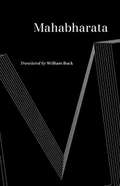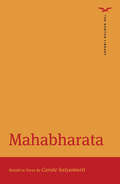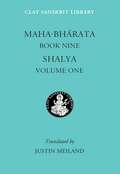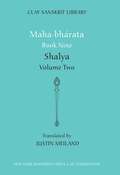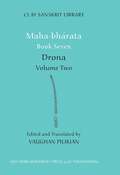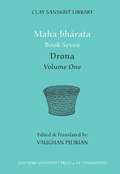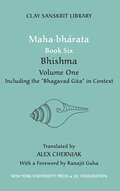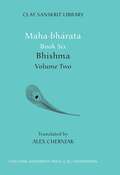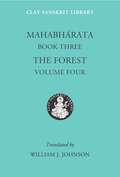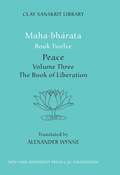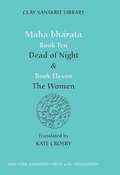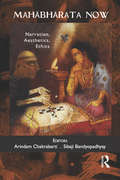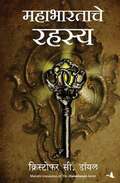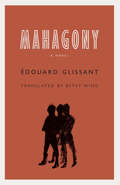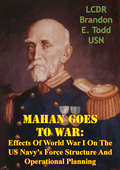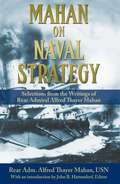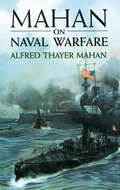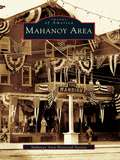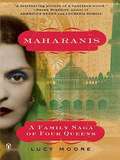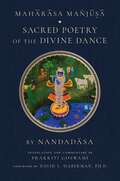- Table View
- List View
Mahabharat
by Gunvant Shahमहाभारत एक विशाल ग्रंथ है तथा इसमें मानवजीवन का सर्वोत्तम इतिहास उपलब्ध है| व्यास ने इसमें मानवस्वभाव के वैविध्यपूर्ण प्रकारों के विषय में अपना दर्शन प्रस्तुत किया है| यह जीवन का इतिहास है, अमर इतिहास है| महाभारत के रूप में यह एक बहुत विशाल विश्वकोश है, जिसकी रचना का श्रेय हमारे देश को है तथा इसमें मुख्य कथा के आधार पर बीच-बीच में अनेक स्थलों पर भूगोल, इतिहास, राजनीति इत्यादि विषयक कई बातों को गूँथ लिया गया है| ज्ञान की विविधता के साथ-साथ व्यापकता में महाभारत बेजोड़ है| जीवन की ऐसी कोई शाखा नहीं बची होगी, जिस पर महाभारत में प्रकाश न डाला गया हो| यह हमारे समाज का `एन्साइक्लोपीडिया' है, विश्वकोश है| विनोबा भावे
Mahabharata
by William Buck B. A. Van NootenA bitter, generation-spanning conflict between two great ruling families for India's most precious lands.
Mahabharata (The Norton Library #0)
by Carole SatyamurtiAbout Carole Satyamurti’s translation “Carole Satyamurti’s version of the Mahabharata moves swiftly and powerfully. She has found a voice that’s capable of a wide variety of expression, and a line—basically classical English blank verse with a jazz-like freedom to swing—that propels the reader effortlessly onward through the cosmic, terrifying, erotic, sublime events of this extraordinary work. I think I shall never get tired of it.” —PHILIP PULLMAN, author of The Golden Compass
Mahabharata Book Nine: Shalya (Clay Sanskrit Library #4)
by Justin MeilandThe Book of Shalya recounts in gory detail the final destruction of the Káurava army and the defeat of its leader, Dur·yódhana. In this first volume heroic duels and martial speeches abound as Shalya, the king of the Madras, is made general of the Káurava army, only to be slaughtered in his turn.The Book of Shalya recounts in gory detail the final destruction of the Káurava army and the defeat of its leader, Duryódhana. In this first volume heroic duels and martial speeches abound as Shalya, the king of the Madras, is made general of the Káurava army, only to be slaughtered in his turn.Co-published by New York University Press and the JJC FoundationFor more on this title and other titles in the Clay Sanskrit series, please visit http://www.claysanskritlibrary.org
Mahabharata Book Nine: Shalya (Clay Sanskrit Library #51)
by Justin MeilandIn one of the most famous passages in Maha·bhárata, Dur·yódhana, the heroic but flawed king of the Káuravas, meets his end when he is dishonorably defeated in battle by his arch-enemy, Bhima. Framing a fascinating account of the sacred sites along the river Sarásvati, the duel poignantly portrays the downfall of a once great hero in the face of a new order governed by Krishna, in which the warrior code is brushed aside in order to ensure the predestined triumph of the Pándavas.Co-published by New York University Press and the JJC FoundationFor more on this title and other titles in the Clay Sanskrit series, please visit http://www.claysanskritlibrary.org
Mahabharata Book Seven: Drona (Clay Sanskrit Library #41)
by Vaughan PilikianVolume Two of "Drona" begins in the aftermath of tragedy. As evening falls, Arjuna journeys wearily back to camp and is greeted by the ashen faces of his brothers. Before they speak, he guesses the worst. And the worst is right: his son Abhimanyu is dead. Arjuna is inconsolable. Insensible with rage, he vows to take revenge on the boy’s killers. He swears that if they are not dead before another day passes, he will set himself alight. The world seems to shudder at his words.
Mahabharata Book Seven: Drona (Clay Sanskrit Library #61)
by Vaughan PilikianAfter Bhishma is cut down at the end of the previous book of the Maha·bhárata, the book which bears his name, Duryódhana selects Drona as leader of his forces. Drona accepts the honor with Bhishma's blessing, despite his ongoing personal conflicts as mentor to both the Pándava and Káurava heroes in their youth. The fighting rages on, with heavy losses on both sides. Furious and frustrated, Duryódhana accuses Drona of collaborating with the enemy, but he replies that as long as Árjuna is on the field, the Pándavas will remain invincible. When Árjuna is finally diverted from the main action of the battle, Yudhi·shthira entrusts Árjuna's son Abhimányu with the task of making a breach in the Káurava formation. Abhimányu rampages through Drona's army, but at last is cornered by several Káurava warriors and finally killed by Jayad·ratha.Co-published by New York University Press and the JJC FoundationFor more on this title and other titles in the Clay Sanskrit series, please visit http://www.claysanskritlibrary.org
Mahabharata Book Six: Bhishma (Clay Sanskrit Library #1)
by Alex Cherniak“Bhishma,” the sixth book of the eighteen-book epic The Maha•bhárata, narrates the first ten days of the great war between the Káuravas and the Pándavas. This first volume covers four days from the beginning of the great battle and includes the famous “Bhágavad•gita (“The Song of the Lord”), presented here within its original epic context. In this “bible” of Indian civilization the charioteer Krishna empowers his disciple Árjuna to resolve his personal dilemma: whether to follow his righteous duty as a warrior and slay his opponent relatives in the just battle, or to abstain from fighting and renounce the warrior code to which he is born.
Mahabharata Book Six: Bhisma (Clay Sanskrit Library #2)
by Alex CherniakThis second half of Bhishma describes the events from the beginning of the fifth day till the end of the tenth of the great battle between the Káuravas and the Pándavas. Despite grandfather Bhishma’s appeal to conclude peace with the Pándavas, Duryódhana continues the bloody battle. The key strategist is general Bhishma, commander of the Káurava forces. Even though he is compelled to fight on the side of the Káuravas, Bhishma’s sympathies are with the Pándavas. After the ninth day of war, when Bhishma has wreaked havoc with their troops, the Pándavas realise that they will be unable to win as long as invincible Bhishma is alive. Bhishma willingly reveals to them how he can be destroyed. Strictly observing the warrior code, he will never fight with Shikhándin, because he was originally born a woman. Bhishma advises the Pándava brothers that Árjuna should strike him from behind Shikhándin’s back, and they follow the grandfather’s advice.
Mahabharata Book Three: The Forest (Clay Sanskrit Library #34)
by William J. Johnson“Slender lady, I came out with you to gather fruit. I got a pain in my head and fell asleep in your lap. Then I saw a terrible darkness and a mighty person. If you know, then tell me - was it my dream? Or was what I saw real?”So speaks Satyavat, newly rescued from the god of death by Savitri, his faithful wife, at the heart of one of the best loved stories in Indian literature. This, and other well known narratives, including a version of Rama's story, bring the Forest Book of the great Sanskrit epic, the Maha·bhárata, to its compelling conclusion. Woven into the main narrative of the Pandavas’ exile, these disparate episodes indicate the range and poetic power of the Maha·bhárata as a whole—a power that has the potential to speak to common human concerns across cultures and centuries.“The Forest” is Book Three of the Maha·bhárata, “The Great Book of India.” This final quarter of the account of the Pándavas’ twelve-year exile in the forest contains four stirring stories that are among the best known in Indian literature. From a hero overcoming great odds, to a virtuous wife who rescues her family, and Indra tricking Karna, and Yudhi·shthira’s victory in the verbal contest with the tree spirit, these stories speak to common human concerns across cultures and centuries.Co-published by New York University Press and the JJC FoundationFor more on this title and other titles in the Clay Sanskrit series, please visit http://www.claysanskritlibrary.org
Mahabharata Book Twelve: Peace Part Two: The Book of Liberation (Clay Sanskrit Library #58)
by Alexander WynneThe Book of Liberation is perhaps the most enigmatic philosophical text from ancient India. Presented as the teachings of Bhishma as he lies dying on the battlefield, after the epic war between the Pándavas and Káuravas, it was composed by unknown authors in the last centuries BCE, during the early period of world-renunciation, when peripatetic sages meditated under trees and practiced austerities in forest groves, and wandering sophists debated in the towns and cities. There has been no time like it before or since: such freedom of thought and expression is unparalleled in the history of the world. The freedom enjoyed by these ancient thinkers was not an end in itself. Above all this animated work is the record of philosophers seeking liberation (moksha) from a world they believed unsatisfactory. The speculation herein is but a means to an end, for its authors believed they could attain freedom from the world by knowing philosophical truths.
Mahabharata Books Ten and Eleven: “Dead of Night” and “The Women” (Clay Sanskrit Library #25)
by Kate CrosbyThe great war of the Maha bharata is over. Or is it? This is a single extended family wracked in conflict. Both sides succumbed to treachery. Ashva tthaman, the young leader of the three survivors on the losing side, is incensed at his father’s murder. He returns after dark to the now sleeping encampment. The sacrifice of the unsuspecting champions, the "Dead of Night," ensues. The five sons of Pandu have escaped. After a final confrontation, a missile crisis, Ashva tthaman concedes defeat but redirects his missile into the wombs of the victors’ women. They miscarry, and cannot hope for more children. Now the survivors, victors and vanquished, must struggle to comprehend their loss. "The Women" of both sides are confronted by their men’s mangled corpses in a masterpiece of horror and pathos. But their potent curses must be curbed to usher in a new era. Maha bharata Books Ten and Eleven give voice to the vanquished, to the psychology of loss and the conflicting desires for understanding and revenge.
Mahabharata Now: Narration, Aesthetics, Ethics
by Arindam Chakrabarti Sibaji BandyopadhyayThe Mahabharata is at once an archive and a living text, a sourcebook complete by itself and an open text perennially under construction. Driving home this striking contemporary relevance of the famous Indian epic, Mahabharata Now focuses on the issues of narration, aesthetics and ethics, as also their interlinkages. The cross-disciplinary essays in the volume imaginatively re-interpret the ‘timeless’ classic in the light of the pre-modern Indian narrative styles, poetics, aesthetic codes, and moral puzzles; the Western theories on modern ethics, aesthetics, metaphysics, psychoanalysis, and philosophy of science; and the contemporary social, ethical and political concerns. The essays are all united in their effort to situate the Mahabharata in the context of here and now without violating the sanctity of the ‘written text’ as we have it today. The book will be of interest to scholars and students of Indian and comparative philosophy, Indian and comparative literature, cultural studies, and history.
Mahabharatache Rahasya: महाभारताचे रहस्य
by Christopher C. Doyleमहान सम्राट अशोकाला जगाचा विनाश करणाऱ्या एका प्राचीन आणि भयावह रहस्याचा शोध लागला होता. महाभारतात खोलवर ते रहस्य गाडून, 2300 वर्षांपूर्वी ते रहस्य जगापासून लपवून ठेवण्यात आलं होतं. काही हजार वर्षांनी त्या रहस्यामुळेच एका निवृत्त अणुशास्त्रज्ञाचा खून होतो. आपल्या पुतण्यासाठी तो केवळ ई-मेलच्या माध्यमातून काही संकेत ठेवतो. गुप्त प्राचीन सांकेतिक लिपीतील संकेतांमधून आणि 2,000 वर्षांपूर्वीच्या अवशेषांमधून त्याचा पुतण्या आणि त्याचे मित्र त्याच्या ई-मेलची उकल करतात. यांच्या या शोधमोहिमेत ते शक्तिशाली दुष्ट शक्तींच्या पाठलागामुळे भूतकाळातील रहस्ये आणि वर्तमानातील कारस्थाने यांच्या कचाट्यात सापडतात. शब्दांत मांडता न येण्याजोग्या भयानक दहशतीचा पगडा जगावर बसण्याआधी 'ते' गूढ ते उकलू शकतात का?
Mahagony: A Novel
by Édouard GlissantÉdouard Glissant&’s novels, closely tied to the theories he developed in Poétique de la Relation (Poetics of relation), are rich explorations of a deported and colonized people&’s loss of their own history and the ever-evolving social and political effects this sense of groundlessness has caused in Martinique. In Mahagony Glissant identifies both the malaise of and the potential within Martinican society through a powerful collective narrative of geographic identity explored through multiple narrators. These characters&’ lives are viewed back and forth over centuries of time and through tales of resistance, linked always by the now-ancient mahogany tree. Attempting to untangle the collective memory of Martinique, Mathieu, the contemporary narrator, creates a conscious history of these people in that place—a record that unearths the mechanics of misrepresentation to get at the fundamental, enduring truths of that history, perhaps as only the mahogany tree knows it.
Mahan Goes To War: Effects Of World War I On The US Navy’s Force Structure And Operational Planning
by LCDR Brandon E. Todd USNA. T. Mahan's 1890 book The Influence of Sea Power on History presented a theory of sea power that proclaimed the capital ship-centered battle fleet essential to any great maritime nation's long-term prosperity. Mahan also formulated a beguilingly simple operational concept based on the teachings of Jomini. His ideas quickly became dogma in the world's navies, including the U.S. Navy. In the decades before World War I, the U.S. Navy's force structure and operational plans reflected Mahan's emphasis on the battleship and fighting as a concentrated fleet.The naval conflict between Germany and Great Britain in World War I did not resemble Mahan's vision for what war at sea between two great powers should look like. Rather than consisting of decisive battles between fleets of capital ships, the War involved distant blockade, raids, mining, and especially commerce raiding by German submarines. Mahan's rival theorist, Sir Julian Corbett, better described the character of World War I.Despite the advantage of almost three years of observing the European conflict, the U.S. Navy did little to prepare for this new kind of war. It entered the War in April, 1917 with a "top-heavy" force of battleships, and operational plans completely unsuited to the anti-submarine conflict it would undertake. This monograph attempts to determine the effects of World War I, a decidedly non-Mahanian war, on the U.S. Navy's force structure and operational planning. These variables manifest the Navy's ends, ways, and means, and thus shed light on the theoretical underpinnings of the Navy's policy.
Mahan on Naval Strategy
by Alfred Thayer Mahan an Introduction by John B. HattendorfThis book makes a valuable and original contribution to the study of strategic thinking of one of the greatest naval theoreticians of all time. Rather than taking one of Mahan’s many works and reprinting it, this volume offers a unique collection of articles and chapters from many books by Mahan, selected to capture the whole range of his thinking. With these key selections, readers have a single, convenient reference to help them toward a full understanding of Mahan’s logic and thinking.
Mahan on Naval Warfare
by Alfred Thayer MahanNaval historians and maritime students alike will welcome this fascinating compendium of writings by one of the world's most influential and respected experts on naval warfare. Considered by many the greatest of all naval theorists, Admiral Mahan was revered by his contemporaries (including Kaiser Wilhelm II of Germany, who made Mahan mandatory reading for his naval officers) for the quality of his insight and analysis.Mahan's close reading of history, his evaluation of the lessons of naval events and his predictions and prescriptions for the conduct of future naval policy contributed powerfully to the shaping of the twentieth century. His influence on naval theorists and policy makers in every great nation was profound, but nowhere was it stronger than among the three "upstart" powers, the United States, Japan and Germany. The Mahan-inspired devotion of these three powers to challenging the naval superiority of the existing naval triumvirate, Britain, France and Russia, and then each other, was among the catalysts for the eruptions of 1914 and 1939.While Mahan's theories received their most cogent statement in his masterwork, The Influence of Sea Power Upon History, 1660-1783, he expanded upon them in many other books, articles and essays. The present volume comprises a rich selection of his shorter pieces. Ranging widely, these selections cover over 40 different topics in a comprehensive discussion of naval principles, sea power in history, and naval and national policies. Taken together, they offer the distilled wisdom, sober evaluations and closely reasoned analysis of a celebrated figure who was an American naval officer in the Civil War, second president of the Naval War College and one of the most outspoken delegates to the Peace Conference at The Hague in 1899.This single volume of selections will enable naval officers, laymen, armchair sailors and students of world history to grasp quickly the essence of Mahan's ideas and their lasting effect upon naval policy and international affairs.
Mahanayak: महानायक
by Vishwas Patilयह उपन्यास एक 'महान कलाकृति' है मात्र इतना कह देने से इसका उचित मूल्यांकन नहीं होता! मै निःसंदेह रूप से कहना चाहता हूँ कि इस शताब्दी की यह सर्वश्रेष्ठ है - वसंत कानेटकर सुभाषचंद्र बोस के जीवन और कर्म पर केन्द्रित 'महानायक' एक श्रेष्ठ भारतीय उपन्यास है! इसमें विश्वास पाटिल ने भारत के एक ऐसे श्रेष्ठ व्यक्तित्व को नायक के रूप में चुना है जो किसी भी महाकाव्य का महानायक बन सकता है सुभाषचन्द्र बाबु उन महामनवों में से एक थे जिन्हें तीव्र बुद्धि, भावनाओं ऊर्जा, प्रखर चिंतनक्षमता जन्म से प्राप्त थी और अपनी पराधीन भारतमाता को स्वतंत्र करने के भव्य स्वप्न से जिनके व्यक्तित्व का अणु-अणु उत्तेजित रहता था! उन्होंने पश्चिमी ज्ञान और विधा को आत्मसात किया था, साथ ही भारत की उर्जस्वनी अध्यात्मिक परम्परा जो रामकृष्ण परमहंस और विवेकानंद से छनकर आयी थी, उनके व्यक्तित्व एवं क्रतित्व का मूल स्त्रोत थी! सुभाष का ऐसा व्यक्तित्व था जिसकी जबरदस्त कशिश ने हिटलर से लेकर जापान के प्रधानमंत्री तोजो तक को प्रभावित किया था और जिसके भय ने चर्चिल जैसे नेताओं की नींद हराम कर दी थी!
Mahanoy Area
by Mahanoy Area Historical SocietyThe Mahanoy area in Schuylkill County is the heart of the anthracite coal region. It is quintessentially defined by hardworking individuals who made their livings around the mining industry, but the area was also the foundation of family fortunes, longstanding business ventures, and political intrigue. Real estate mogul Charles D. Kaier began the mostup-to-date brewery of the day here; early resident John Smith built his lavish fourteen-room mansion for $40,000 in 1908; and the controversial Mollie Maguires--a secret society of Irish coal miners who used violence against mining hierarchy--were based here.
Maharanis
by Lucy MooreIn MAHARANIS Lucy Moore brilliantly recreates the lives of four princesses - two grandmothers, a mother and a daughter - of the Royal courts of India. Their extraordinary story takes in tiger hunts, exotic palaces and lavish ceremonies in India, as well as the glamorous international scene of the Edwardian and interwar era. It is also an intimate portrait of four remarkable women - Chimnabai, Sunity, Indira and Ayesha - who changed the world they lived in. Through their lives Lucy Moore tells the history of a nation during an era of great change: the rise and fall of the Raj from the Indian Mutiny to Independence and beyond.
Maharasa Manjusa: Sacred Poetry of the Divine Dance
by Prakriti GoswamiAn annotated translation of Nandadasa&’s poetic rendition of the five chapters of rasa-lila in the Bhagavata, highlighting the text&’s musical legacy, devotional worship, and Vedantic foundations.Maharasa Manjusa: Sacred Poetry of the Divine Dance provides translation and scholarly commentary of Nandadasa&’s five chapters of rasa-lila, collectively known as the rasapancadhyayi. In the Vaisnava tradition propounded by Vallabhacarya, Nandadasa is considered to be one of the eight devotional poets, whose compositions are exquisitely detailed with description of both Krsna&’s cosmic form and his divine play. This gradually developed into a distinctive style of performing art, haveli-sangita, which is practiced even today. Maharasa Manjusa: Sacred Poetry of the Divine Dance brings out the poetics, narrative style, and idiosyncrasies of the recitation of devotional poems from the region of Vraja in the 16th Century. An exquisite specimen of devotional poetics, Nandadasa&’s Rasapancadhyayi is a Braja-Bhasa rendition of the Bhagavata&’s quintet of Maharasa written in Sanskrit verse. The Bhagavata is one of the most beloved texts of Krsna-devotional traditions and the foundational scripture of Braja Vaisnavism and its five chapters describing the divine dance illustrate the ecstatic fruit of devotion. Presenting a devotee&’s execution of the Maharasa while examining its interpretative themes underpinned in the epistemology of Vallabhacarya, Maharasa Manjusa: Sacred Poetry of the Divine Dance offers an intensive view of the musical legacy, a devotee&’s worshipful interactions, and Vedantic foundations of the ecstatic devotion expressed by Nandada¯sa. The introductory chapters provide first compendious study of the theo-aesthetic, epistemic, and liturgical framework of Pustimarga&’s orthopraxis that have fuelled this lyrical delivery. Enriched with annotations, the translations are literal while offering nuanced insights into the colloquial intricacies of Braja-Bhasa poetics and the cultural expressions of the Braja region.
Maharashtra Mahodayacha Purvrang: महाराष्ट्र महोदयाचा पूर्वरंग
by Narayan Krushna Gadre"महाराष्ट्र महोदयाचा पूर्वरंग" हा कै. नारायण कृष्ण गद्रे यांनी लिहिलेला ऐतिहासिक ग्रंथ आहे, जो महाराष्ट्राच्या सामाजिक, धार्मिक, आणि राजकीय उत्कर्षाचे सखोल वर्णन करतो. ग्रंथाचा कालखंड शालिवाहन शतक ते मराठ्यांच्या स्वराज्य स्थापनेच्या पार्श्वभूमीपर्यंत आहे. लेखकाने ऐतिहासिक घटनांचे दस्तऐवजीकरण करत महाराष्ट्राच्या वैभवशाली इतिहासाचा आलेख उभा केला आहे. बखरी, कागदपत्रे, आणि तात्कालिक साधनांवर आधारित लेखन प्रौढ भाषा व संशोधनात्मक दृष्टिकोनाची ओळख पटवतो. पुस्तकाने वाचकांमध्ये स्वदेशाभिमान जागृत करण्याचे कार्य साधले आहे. महाराष्ट्राच्या सांस्कृतिक, धार्मिक, आणि वाङ्मयीन परंपरेचा मागोवा घेत, लेखकाने मराठ्यांचा विजयनगर साम्राज्याशी असलेला संबंध आणि स्वराज्यस्थापनेचा मार्ग प्रकाशझोताखाली आणला आहे. या पुस्तकाचा आशय अत्यंत ज्ञानवर्धक असून महाराष्ट्र राज्य साहित्य मंडळाने याची पुनर्मुद्रित आवृत्ती प्रकाशित केली आहे, ज्यामुळे आधुनिक वाचकांना या अमूल्य साहित्याचा लाभ होईल.
Maharashtrache Shilpkar Nana Patil: महाराष्ट्राचे शिल्पकार नाना पाटील
by Bharat Patankar"महाराष्ट्राचे शिल्पकार नाना पाटील" हे भारत पाटणकर लिखित पुस्तक महाराष्ट्राच्या इतिहासातील एक महत्वाचे व्यक्तिमत्त्व नाना पाटील यांच्या जीवनावर आधारित आहे. नाना पाटील, ज्यांना "आझाद" म्हणुनही ओळखले जाते, त्यांनी भारताच्या स्वातंत्र्यलढ्यात महत्वपूर्ण भूमिका बजावली होती. पुस्तकाची कथा त्यांच्या जीवनातील प्रमुख घटना, त्यांच्या कार्याची तत्त्वे, आणि त्यांनी केलेल्या संघर्षांवर प्रकाश टाकते. विशेषत: १९४२ च्या चलेजाव चळवळीच्या दरम्यान त्यांनी प्रतिनिधी सरकार (Parallel Government) स्थापन करण्याचे धाडस केले होते. या सरकारने ब्रिटिश राजवटीविरुद्ध संघर्ष करताना स्थानिक प्रशासन, न्यायव्यवस्था आणि शिक्षणाच्या क्षेत्रात महत्वपूर्ण काम केले. पुस्तकात नाना पाटील यांच्या क्रांतिकारी विचारधारांची आणि त्यांच्या नेतृत्वाची सविस्तर माहिती दिली आहे. त्यांच्या कार्याची महत्ता, त्यांनी अनुभवलेल्या अडचणी आणि त्यांनी केलेले त्याग यांची चर्चा या पुस्तकात केली आहे. त्यांनी स्थानिक लोकांमध्ये जागरूकता आणि स्वातंत्र्याची प्रेरणा कशी निर्माण केली, याचे वर्णनही पुस्तकात समाविष्ट आहे. या पुस्तकातून नाना पाटील यांची प्रेरणादायक जीवनकथा समजते आणि महाराष्ट्राच्या स्वतंत्रता संग्रामातील त्यांच्या योगदानाची सखोल माहिती मिळते. त्यांच्या संघर्षमय जीवनाचा अभ्यास करताना, वाचकांना त्यांच्या धैर्य, संकल्प आणि नेतृत्वाचे दर्शन घडते.
Maharshi Vinoba Bhave
by Mira Bhattમહર્ષિ વિનોબા ભાવે એ નવજીવન દ્વારા પ્રકાશિત સંતવાણી ગ્રંથાવલિનું આઠમું પુસ્તક છે. સંતવાણી ગ્રંથાવલિ એ ભારતના મહાનુભાવોના જીવન અને વિચારને વાચક સુધી પહોંચાડવાનો નવજીવન ટ્રસ્ટનો નમ્ર પ્રયાસ છે.

